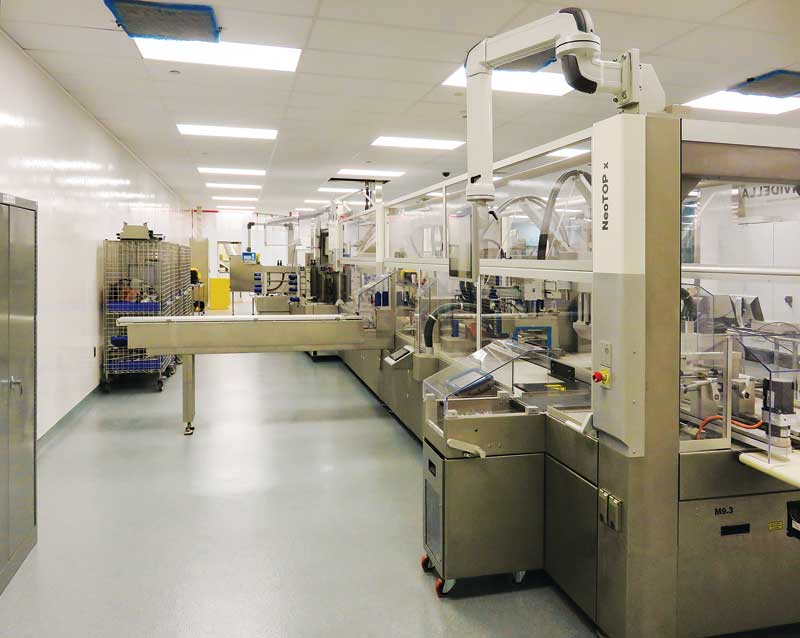
Photo courtesy Crane Composites
Mineral fiber
Mineral fiber panels generally provide good acoustical properties, including noise reduction coefficients (NRC) and ceiling attenuation coefficients (CAC). They can also be used in floor-ceiling assemblies providing good sound transmission coefficients (STC). Certain mineral fiber panels can be used in fire-resistance-rated floor-ceiling assemblies.
Panels are made of synthetic vitreous fibers such as glass, rock, or slag wool and a binder. These fibers have an inherent limitation regarding hygienic use—fibers are friable and can be dislodged, rendering panels visually less attractive and potentially releasing fibers into a room. To overcome this, mineral fiber panels for hygienic ceilings are typically faced with plastic or metal foil, or another readily cleanable surfacing agent.
While fibers do not migrate through the faced surface, they can still be released while cutting, handling, installing, and maintaining panels. Mineral fiber panels are frangible, with corners and edges potentially breaking off when accessing the above-ceiling cavity. While each incident may release only a small quantity of fibers, they can accumulate and eventually pose problems. In some especially sensitive areas, even a small quantity of fibers can be unacceptable.
The safety data sheet for a typical mineral fiber ceiling panel promoted for use in healthcare and food-processing areas warns installers they should work in well-ventilated worksites, avoid breathing dust, wash thoroughly after handling, and “obtain special instructions before use.” Recommended personal protective equipment includes splash-resistant safety goggles with a face shield, chemical-resistant clothing and gloves, and, under certain conditions, respirators approved by National Institute for Occupational Safety and Health (NIOSH). The safety data sheet also states the product can cause skin, eye, and respiratory tract irritation, be a cancer hazard, or lead to lung damage. These statements may be hyperbole required by product liability attorneys—indeed, the safety data sheet also says ill effects are not expected during “normal use” and do not present known health effects when properly installed and maintained.
Therein may lie the rub. Occupancies requiring hygienic conditions are not “normal use.” Further, it is hard to ensure products will be properly maintained; removing panels for above-ceiling access can dislodge fibers, and it may be impractical to shut down a facility every time the ceiling is touched.

Photo courtesy Paradiso Pizza and Subs (Kingston, Ontario)
Most mineral fiber products have the propensity to absorb water and support fungi—thus, the potential for mold and mildew spores can be a concern. Many mineral fiber panels promoted for hygienic conditions have antimicrobial treatments (a topic discussed later in the article), but surface-applied coatings do not provide protection to panel cut edges or penetrations.
Some treated panels come with multi-year limited warranties. Warranties are commercial agreements and not statements of performance, and their limitations must be carefully considered. For example, the warranty from one manufacturer excludes damage due to roof leaks, sweating pipes or equipment, condensation on windows and other surfaces, and humidified air. These are leading sources of the moisture contributing to mold growth, so the value of the warranty is unclear.
Gypsum board
The paper faces of typical gypsum board are not washable. This means they require high-performance paint, plastic or metal foil, or other readily cleanable finish for hygienic applications. Further, gypsum board ceiling panels have good noise-blocking properties, but negligible NRCs. Products usable in fire-resistance-rated floor-ceiling assemblies are available.
While the safety data sheet of a typical manufacturer says gypsum board does not pose a risk to health under “normal conditions of intended use,” it does recognize respirable crystalline silica is present and that dust from the product can be a respiratory irritant if released due to inappropriate handling during, for example, above-ceiling access. This could be a factor when airborne particulates and dust must be stringently controlled.
Most gypsum board products can support fungi and mold growth if exposed to water.




